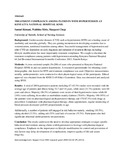| dc.contributor.author | Kimani, Samuel | |
| dc.contributor.author | Waithira, Mirie | |
| dc.contributor.author | Chege, Margaret | |
| dc.date.accessioned | 2013-12-04T16:51:21Z | |
| dc.date.available | 2013-12-04T16:51:21Z | |
| dc.date.issued | 2013-06 | |
| dc.identifier.citation | Kimani, Samuel, Waithira, Mirie, Chege, Margaret,June,2013.Treatment Compliance Among Patients With Hypertension At Kenyatta National Hospital (KNH),presented at the 2nd International Scientific Conference, CHS And KNH, 19th - 21st June 2013. | en_US |
| dc.identifier.uri | http://hdl.handle.net/11295/61859 | |
| dc.description | Treatment Compliance Among Patients With Hypertension At Kenyatta National Hospital (KNH),presented at the 2nd International Scientific Conference, CHS And KNH, 19th - 21st June 2013. | en_US |
| dc.description.abstract | Background: Cardiovascular diseases (CVD) such as hypertension (HTN) are
a leading cause of morbidity and mortality globally. They are gaining momentum
in developing countries due to westernization, nutritional transition among others.
Successful management of hypertension and other CVD are dependent on early
diagnosis and initiation of treatment therapy including lifestyle modifications but more
importantly treatment compliance. We sought to elucidate the treatment compliance
among patients with hypertension attending Kenyatta National Hospital.
Methods: A cross-sectional sample (N=200) of cases who presented at Kenyatta
National Hospital (KNH) in and out-patient departments. A structured questionnaire
for obtaining socio-demographic, risk factors for HTN and treatment compliance
was used. Objective measurements notably, anthropometrics were conducted to elicit
physiological status of the participants. Ethical approval was obtained from the KNH/
UoN Ethics Committee. Data was abstracted and analyzed using SPSS.
Results: A total of 200 hypertensive patients including 87 (43.5%) males were
recruited with the average age of patients and illness being 52.7 and 5.8 years, while
most (31.7%) patients were 60 years and above. Majority (96.5%) of patients were
aware of their hypertensive status while 68 (34%) were suffering from other co
morbidities mainly diabetes (70.6%). Majority 190 (95%) of the patients were on
pharmacological antihypertensive therapy and 175(87.5%) took drugs as prescribed.
Compliance with pharmacological therapy, clinic appointment, regular monitoring of
blood pressure decreased (p<0.05) proportionally to age.
Additionally, a number of patients still engaged in risk behavior namely, smoking
(10.5%), taking alcohol (13.5%), adding salt (55%) and lack of exercise (35.5%).
Participants also had significant abnormal anthropometric measurements.
Conclusion: The results underscore the need to develop appropriate strategies to target
specific behavioral interventions among clients with hypertension to leverage with
pharmacological compliance. Emphasis on the importance on lifestyle modification
for control and prevention of risk factors may delay development of complications,
improve quality of life and assure longevity.
Acknowledgement: Support from KNH research grant (KNH/23/22 (PI) (2012). | en_US |
| dc.language.iso | en | en_US |
| dc.publisher | University of Nairobi | en_US |
| dc.title | Treatment Compliance Among Patients With Hypertension At Kenyatta National Hospital (KNH) | en_US |
| dc.type | Presentation | en_US |

